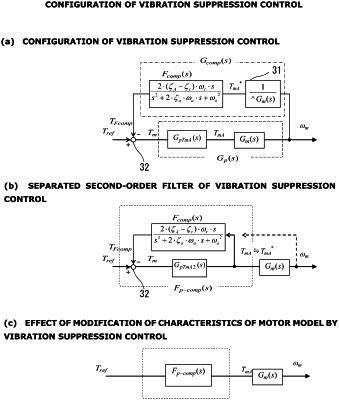| CPC H02P 23/04 (2013.01) [B60L 15/20 (2013.01); G05B 13/042 (2013.01); H02P 23/12 (2013.01); B60L 2240/12 (2013.01); B60L 2240/421 (2013.01); B60L 2240/423 (2013.01); B60L 2240/465 (2013.01); B60L 2270/142 (2013.01)] | 15 Claims |

|
1. A vehicle system vibration suppression control device for a vehicle system in which a vehicle is driven via an elastic shaft by a motor drive device having a torque control function, the vehicle system vibration suppression control device comprising:
at least one controller configured to:
contain an approximate model to which an output torque command (Tm) is inputted;
calculate a motor-accelerating torque component (TmA*) by differentiating a measured speed component (ωm) of a motor rotational speed;
produce a compensation torque component (TFcomp) by causing the motor-accelerating torque component (TmA*) to pass through a vibration suppression control filter (Fcomp(s));
calculate the output torque command (Tm) by subtracting the compensation torque component (TFcomp) from an input torque command (Tref); and
instruct the motor drive device to generate a motor torque corresponding to the calculated output torque command (Tm);
wherein the vibration suppression control filter (Fcomp(s)) is expressed by a mathematical expression (13),
 where
s: a Laplace operator,
ωr=√(Kd·(1/TJm+1/TJwM),
ωa=√(Kd·(1/TJwM)),
ζr=(Kd·Ds)/(2·ωr),
ζa=(Kd·Ds)/(2·ωa),
ζA: an adjustable parameter,
Ds=TJM/(TJw+TJM)·Kt,
TJm: a time constant equivalent to motor inertia,
TJw: a time constant equivalent to driving wheel inertia (a combined value of multiple driving wheels),
TJM: a time constant equivalent to vehicle mass,
Kd: a torsional stiffness coefficient of driveline,
Kt: a coefficient relating to friction between tire and road surface, and
TJwM=TJw+TJM.
|